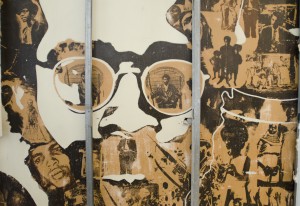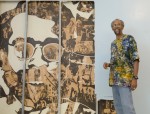Piece by piece, workers slowly unveiled worn portraits and faded images of moments past but not forgotten, revealing a piece of UCLA history that has remained dormant behind drywall for more than 20 years.
Past and present UCLA community members gathered in Ackerman Union on Friday afternoon to begin the restoration of “The Black Experience” mural, which was painted by UCLA students more than 40 years ago, and later covered by a false wall during an Ackerman remodel.
For the past year, Associated Students UCLA, the Afrikan Student Union and other UCLA students and officials have been working to restore the mural as a way to increase the representation of UCLA’s black students and their history on campus, said Devin Murphy, a third-year political science student and a member of the Afrikan Student Union.
Kamilah Moore, a fourth-year political science student and the chair of the Afrikan Student Union, said the mural’s restoration was long overdue.
“Forty years, it’s been way too long,” she said, standing in front of the mural at the ceremony. “By restoring the mural, we’re valuing people over profit.”
The image was first crafted in the midst of the Vietnam war protests, when seven black art students at UCLA decided to paint a mural of their faces, silk-screened with pictures of notable people and scenes from the black community.

When the art students thought of the idea for the mural, the administration planned to paint the walls in Ackerman Union anyway, Garrick said. He and his fellow art students submitted a proposal to the administration requesting to use the wall and funds equalling the amount the administration would have used to paint it anyway, he said.
Garrick said that he and the other artists chose people or scenes that were inspirational to them to incorporate into the art, such as his philosophy teacher who served as his mentor.
“She is (painted) on my chest,” he added, tapping his palm over his heart.
The campus shut down for the rest of that spring, Garrick said. People were covering the campus with graffiti to personally express their anger and frustration, he said.
But he and his fellow students wanted to express themselves culturally rather than personally, he said.
“This (current) generation is a ‘me’ generation, (mine) was a ‘we’ generation,” Garrick said.
In 1992, the mural of the artists’ faces was hidden by a false wall during a remodeling of Ackerman. Several holes were drilled directly into the mural and Panda Express covered the right border of the art piece, said Roy Champawat, director of the UCLA Student Union.
Jason Smith, a former member of the Afrikan Student Union, began to push for restoration of the mural last year.
Smith said he read an article about the mural in the Daily Bruin in May 2010. But a course he took called “Beyond Mexican Mural: Beginning Muralism and Community Development” was what inspired him to take initiative to bring back the mural.
Smith, along with other members of the Afrikan Student Union, brought up a mural restoration proposal at the ASUCLA Board of Directors meeting in fall 2012.
The ASUCLA Board of Directors is contributing $43,000 and Panda Express is paying $60,000 for the mural’s restoration, Champawat said. The majority of the work to restore the mural will take place during winter break, when Panda Express‘ business slows significantly, Champawat said. He said he estimated the work will be mostly done by the end of winter break.
“It’s great to have a piece of history in the union,” Champawat said. “All of the art on our walls is student art, and (the mural) may be the first piece of student art.”
Helen Singleton, another one of the artists and a Freedom Rider, said she contributed to the mural because she felt underrepresented when she was a student at UCLA.
“What we felt as black students (was) ‘This university doesn’t know who we are,'” she said during the ceremony.
The restoration of the mural will provide black students – and UCLA students overall – a greater sense of their history and will serve to represent them on campus, Singleton added.
Watching the wall coming down and a full portrait being revealed was powerful, Moore said.
“It feels like the experience of black students and (other) students of color, even all UCLA students, is being valued,” Moore said.

Neville Garrick’s philosophy professor and life mentor was Angela Davis.
Angela Davis was Neville Garrick’s philosophy professor and life mentor.
This is really exciting. I was only five when this was painted, and never got a chance to see it despite having first transfered to UCLA in the Spring of 1991. I’m glad that now as a readmitted student I will have the opportunity to view it in the process of being restored. Resistance to imperialist wars and the ongoing struggle for black liberation are important things to document, and art like this tends to capture the spirit and intent of the time.
One thing I’d have to disagree with Neville Garrick on is the concept of generational values. As a member of generation-X I straddle the gap between Garrick’s era, and the current generation of students enrolled. While there was certainly a greater sense of a “we” amongst the baby boomer generation during the 60’s and 70’s, the dominant culture reasserted itself and the boomers themselves took on the role of selling the “me” concept to subsequent generations. That’s not to say that many baby boomers aren’t socially conscious and engaged in struggle, and it would be my guess that Garrick fits that mold. However, I’ve grown weary of the boomers pointing to both generation-Y and millennials and saying they have a “sense of entitlement,” or are the “me” generation. If any part of that’s true, it’s because the dominant “white supremacist capitalist patriarchy” has taught them to act so.
It’s our job (eg. Garrick’s and my generation’s) to encourage a sense of community and collectivism in the current generations, since the dominant culture and its vast superstructure works to do just the opposite.